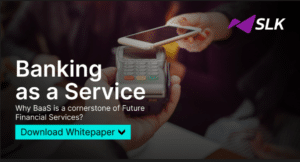The BaaS Transformation: Why Intelligent Banks Are Turning into Tech Providers?

Increasing digitalization is pushing the financial services (FS) industry toward new paradigms. Specifically, the rise in digital tech accessibility is slowly turning non-banking firms into financial services providers via embedded finance and BaaS.
While it can be hard for most companies to acquire the necessary charter and licensing to operate in the FS space, embedded finance offers a workaround. Banks and non-financial firms are increasingly searching out IT solutions that help them embed financial products and services into their existing product offerings.[1] And that’s where BaaS comes in.
What can BaaS truly offer banks?
To carve out a competitive advantage, banks may find that upgrades to both back-end systems and front-end customer experience delivery are in order. This means investing in new technology platforms, embracing omnichannel as table stakes, driving demand decisions with real-time data, and integrating modern infrastructure into legacy banking cores. To meet these expenditures, smart banks are looking at BaaS as a highly profitable revenue stream.
BaaS also offers an opportunity to drive customer acquisition at significantly lower costs. .[2] This is partly because embedded finance moves financial services and products closer to critical customer touchpoints, significantly shortening the customer acquisition funnel. Additionally, by using embedded finance via BaaS to reach new audiences, banks essentially piggy-back their customer acquisition onto their consumer-facing partners, reducing marketing and on-boarding spend.
And besides customer acquisition, BaaS can help banks harness fintech partners and distributors to open new accounts across the FS portfolio, cross-sell investments, and insurance, and build larger streams of interchange fees.

Building a strategic digital foundation for BaaS
From a technological standpoint, BaaS can be delivered via many routes. For example, you could build on your existing tech stack and use third-party plug-ins and APIs to connect with fintech partners. And, of course, you could also construct an entirely new greenfield platform customized for BaaS and scale as your opportunities develop. Here are a few key considerations when building a foundation for BaaS offerings.
- Identifying your opportunities and partners – Once you have defined your BaaS strategy, the next step is to identify the fintech partners and distributors. When partnering with another business, it is important to align the goals and maturity levels to manage risk appropriately. By doing so, you can ensure that the partnership is beneficial for both parties involved. Using structured risk analysis alongside a qualitative assessment of future technology use cases, scaling strategy, market compatibility and long-term strategic alignment is a great way to make sure your BaaS partners will be around for the long-haul.
- Establishing your product portfolio – Creating a catalog of potential product customizations will help you map the technological base for BaaS. For example, will you leverage your legacy banking core or build an entirely new platform? The answers you find will help you tackle the build-buy-partner equation when it comes to BaaS technology.
- Creating an API library – The API configurations for payments and deposits will vary significantly from those used to extend loan origination and credit facilities. Ideally, BaaS providers should work towards building a powerful and robust API library that holds up to open banking standards, is well-documented, and integrates seamlessly with a variety of partner systems.
- Implementing security fail-safes- Experts at PwC estimate that 40% of banking fraud in 2022 stemmed from bad actors gaining access to bank systems via digital platforms.[3] As the BaaS wave gains momentum and FS providers make the shift to open banking, many threat vectors are exposed to would-be hackers. Countering these threats means establishing a dedicated cybersecurity framework and monitoring data flows both internally and on third-party platforms interfacing with your systems.
- Finding the right tech advisory – When picking an IT partner, don’t just throw the proverbial dart at a list of vendors. Instead, look at how peers and first movers in the industry have structured their offerings and the partnerships they’ve built. This sort of competitive analysis can give you an idea of the mistakes you shouldn’t make and can also furnish you with a list of IT solution providers that have experience in tackling real-world BaaS challenges.
Get in touch with us if you need more details to get started on your BaaS transformation.




